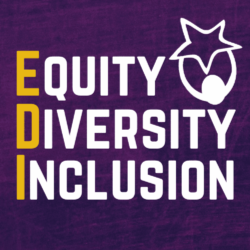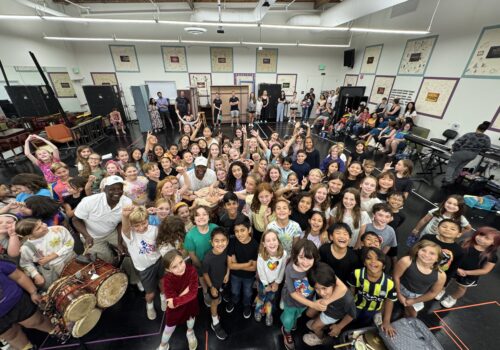CMT’s commitment to producing theater opportunities through an equitable lens is a natural extension of our artistic vision, built on inclusivity and excellence. CMT leadership along with an active committee of alumni, parent volunteers, and board members are committed to strengthen our efforts towards Diversity, Equity, Inclusion & Belonging (DEIB). Together, we have developed a 3-year plan which serve as a road map to strengthen our commitment to eliminate racial bias within our organization, and do our part to impact our community through equality and systemic change.

Diversity. Equity. Inclusion.Belonging.
Guiding Principles
The following principles were created by our original diversity committee and accepted by the Board and CMT leadership in 2020. These aspirations influence the planning and decision making across the full spectrum of the organization. Progress has been made since these principles were created and we will continue to evolve in the seasons that follow.
We will review and revise our policies and procedures to align with the organization’s mission statement to these new goals, through an anti-racist lens:
- We will create programming that gives voice and expression to Black/Indigious/People of Color’s (BIPOC) lives, experiences and histories.
- We will educate our performers on the historical background of the stories they are telling, encouraging critical analysis through an anti-racist lens.
- We commit to color-conscious casting with the intention of honoring the characters’ identities and authentic stories.
- We will deepen our commitment to recruit and hire BIPOC artistic and production staff.
- We will continue to recruit Board members that reflect the diversity of our community.
- We will enhance inclusive recruitment and hiring practices throughout all levels of the organization including staff, management and Executive leadership.
- We will expand our outreach with the goal of making participation in CMT programming more accessible to all.
- We will engage in active dialogue and commit to listening and responding quickly to the needs of our BIPOC artists, staff, and community.
- We will hold our organization and selves accountable to on-going anti-racist training, learning and conversation.

Diversity Alliance Committee
- Stacy Galaviz – Committee Chair
- Anita Reyes
- Rudy Fuentes
- Sherri Vasquez
- Erez Yereslove
What’s New:
In honor of Black History Month, CMT celebrates African American artists who inspire and educate the next generation of artists and patrons. We appreciate and value the contributions of all individuals, regardless of their race or ethnicity. By celebrating Black History Month, we can honor the contributions and achievements of Black individuals who have made an impact on the performing arts, working towards a more diverse and inclusive future.
CMT’s Winter Mainstage production of Head Over Heels is directed and choreographed by CMT alum, Ivan Bracy Jr. Ivan was actively involved at CMT from 2012 – 2016. He is a recent graduate of Point Park University and is a professional actor, currently residing in Chicago. Our Mainstage performers have been lucky enough to welcome Ivan “home” to CMT to bring this new production of love and acceptance to life. We caught up with Ivan earlier this month to learn more!


What drew you to this project of Head Over Heels and what are you most enjoying in your role of Director/Choreographer?
I was drawn to Head Over Heels because of its fun and joyful truth found within the text of the script. The story of this show has so many complex layers that mirrors the world we live in today. To be able to bring Head Over Heels alive with this age group was an incredible opportunity that couldn’t pass. A lot of the material is what Mainstagers experience in exploring, adventure and jamming out.
Do you have any memories from your time as a CMT performer that either feels familiar as you work with today’s Mainstage performers OR something that has evolved since you were active here?
The wonderful thing about this process is that it really comes with a beautiful parallel to experiences that I shared with artistic staff in show I’ve been in with the CMT community. Now being on the other side of the table in a directorial and choreography position, moments that I had with Joey Dippel in Cats and Claire Alexander with my first show as a rising star Aladdin Jr. These two artists pushed us in such an exploratory way while listening to our thoughts to add to the production. The artists in Head Over Heels are too now being challenged to bring new styles of dance to the Montgomery stage, not to mention one of the biggest challenges: Shakespearean verse.
What was that moment as a young person when you decided that you wanted to pursue a career in the arts? Growing up in the Bay Area I use to do my elementary and middle schools production and grew to love the activity near the ending years of my time in middle school. During my 8th grade year, two events happened which locked my mind into wanting to take on the path of venturing into becoming a professional actor in the theatre world. In this year my class went to see the rising star production of Godspell where they mentioned their next production was Aladdin Jr, which lent to a perfect transition into a wider community of artists with more ways to expand. The second event that locked in my desire to jump into the world of the arts was the touring production of Wicked.
As an artist of color, what challenges do you face as you navigate auditions, casting, and performance, or joining other artistic teams? The world of the arts in the past couple of years have made a grand, much needed, jump away from the traditions in which Broadway grew up on. Finding auditions whether at regional theatre, tours, and on Broadway are more available than ever. Being a POC is in after the shift in awareness and education of most creative teams. Nearly 70% of shows produced have scripts which hold characters that aren’t written to be strictly white. The roles of theatre are open to exploring a new image of characters not cornering them into one appearance. The challenge often lies in casting tables. All should be challenged to not go into the room or a production with a preconceived image of the color of a role, as most roles are interchangeable.
What advice do you have for younger artists of color, hoping to pursue a career in the arts?When given the chance to tell artists of all colors I say, “Stay true to yourself and story and don’t try to blend in.” In todays world of theatre a person of color has an upper hand and being a person of color is wonderful thing to be. There are many artists old and new that are coming out of new productions local and mainstream that represent all POC big, small, and tall. Which is why I circle back to–as cheesy as it may sound–be yourself with pride and learn to know what you have no one else can present like you. Never stop learning and crafting your talents. Everyone has areas to grow in.
What would you recommend to arts organizations like CMT who are working to broaden diversity in their casts and artistic leadership?
With finding new connections in the Bay Area, to find a more diverse community, a great thing to explore other than reaching out is to actually see and venture into traveling to diverse communities to see their works in person. The care comes from one on one experiences and conversations. Yes it’s wonderful too to continue to reach out and possibly extend the invitation to communities who maybe have diverse programs in dance, vocal groups are even interest in any field of performing arts. It’s a two way street so that the first actions don’t seem transactional but truthful, which will later form the revisiting tie between communities.
Local Connections
On October 1, James Henry of House of Samba Kids came to do a West African drumming workshop with our cast of The Lion King Jr. The workshop was an interactive educational workshop that used music, rhythm, percussion instruments, and drums as tools for capturing the imagination of the participants.


